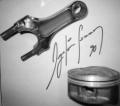I've been doing various simple servicing on the NSX (oil, cleaning air filter & throttle body) in readiness for Japfest and just drove the car fairly fast to test the new Yokohama AD08 tyres & was doing some hard braking (usually I'm very light on brakes on normal in traffic driving). I noticed the brake pedal felt a lot harder than I remembered. In the past I had a soft but good braking performance and then a progressive feel & further braking performance.
Further into my drive I pressed the brake really hard to test the performance and managed to get the tyres to lock up and make a pretty loud tyre screech! This was at about 40mph, I let off the pedal as soon as it locked. So the braking performance was there but the pedal needed a fair amount of effort.
When I got home I tested to see whether the brake servo was working so I pressed the brake pedal lightly without the engine running and then started the engine and the pedal went down further with the same applied pressure. Checked the vacuum hose under the bonnet and that was fine - Haven't checked the rest of the vacuum line. Brake pads seem to have about 4mm front and back.
I realised the ABS didn't seem to activate when the tyres locked up but I did release pretty quick. However when thinking about it I haven't heard the ABS pump the system in a long long time (could be months). I used to hear it at least once if I hadn't driven the car in a while.
The ABS light illuminates and then disapears shortly after the engine starts as it should.
So it seems I have a hard brake pedal and my ABS pump isn't pumping / working? I don't know whether these problems are linked. Can anyone shed any light on this?
Cheers
Ed



 Reply With Quote
Reply With Quote





